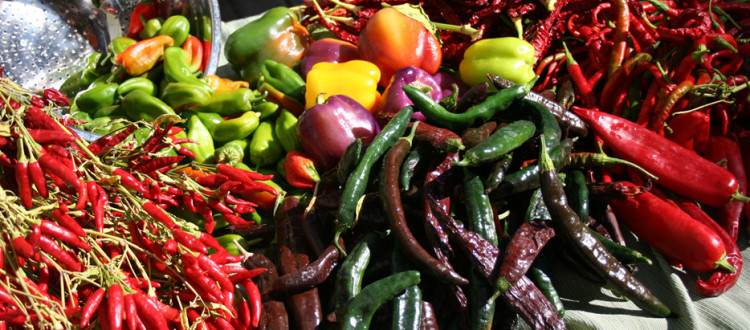Chile Peppers
Edit Chile Peppers in the below Page Builder Section.
Chile Peppers
Chile (or “hot”) peppers (Capsicum annuum) are similar to their sweet tasting cousins except for the fact that chile peppers produce capsaicin, a lipoid that binds with the pain receptors in the mouth and tongue, alerting the brain that something very spicy has been ingested.
Hot peppers are graded for intensity using the Scoville Heat Unit (SHU). A bell pepper is a “zero” while a jalapeño, by comparison, can reach up to 10,000 SHU. The scale continues up much further from there, with habañero peppers tipping the Scoville scale at around 350,000 SHU. Other super hot varieties have been developed that make the habañero seem mild.
Peppers are native to the Americas and comprise a major part of many ethnic foods around the world. Peppers in general are easy to grow and most are pest resistant. A hot pepper plant requires more time for the fruit to ripen than sweet varieties.
Visit our product listings for pepper varieties that grow well in our area.
How to Plant
Peppers of all kinds like sandy, loamy soil that drains well and full sun. They require even amounts of watering, but avoid over-watering as their roots don’t like being too wet. To avoid letting the soil dry out between waterings, use a mulch to reduce evaporation and
retain moisture.
Space pepper plants 12 to 18 inches apart. Pepper plants become laden with fruit, so staking them early is a good idea. Avoid using wire ties as they will stress or even choke the main stem as it grows, causing damage to the plant and reducing yields. Try using an old nylon that can expand with the plant as it grows.
Fertilizing
Peppers are not heavy feeders. Begin by using a 5-10-10 fertilizer worked into the soil before transplanting. An additional round of fertilizer may be required by mid-season and should be added to the top of the soil around the plant and gently watered in.
Harvesting
Gardeners growing peppers are faced with a dilemma when harvesting: if harvested before fully ripening, the flavor will not have reached its peak. If you wait until the end of the season when they’re fully ripened, your yield will be reduced.
One strategy that works is to plant two groups of peppers: one that is continually harvested (for best yields) and one that is not harvested until all of the fruit is fully ripened. The extra flavor in the fully ripe peppers helps offset the reduced yields.
Use sharp, clean shears or scissors when harvesting the fruit to avoid damaging the plant.
Recommendations for Use
The best time to eat a hot pepper is right after picking it. They can be left on the counter for a couple of days to let them continue ripening. Avoid refrigeration as this damages the pepper and reduces flavor.
Freezing peppers works well and retains their flavor, but it softens the pepper. Drying peppers also is popular, but the best way to dry them is to do it slowly. Avoid touching your eyes after handling peppers.

